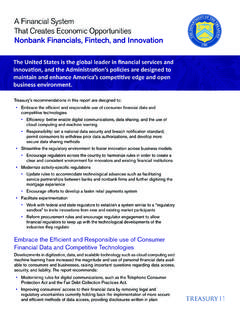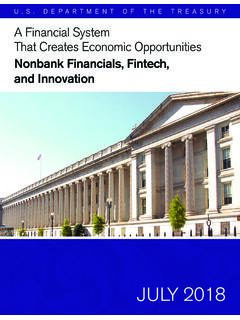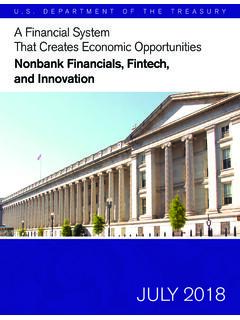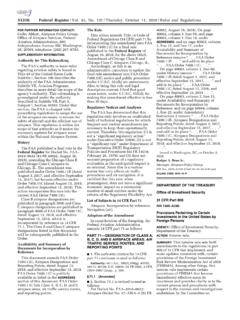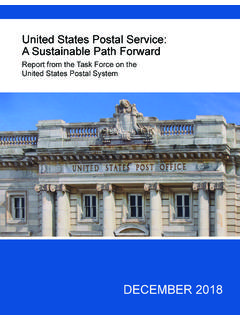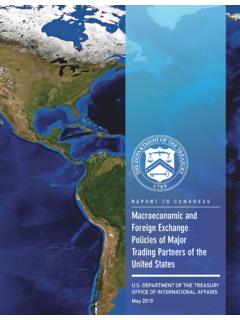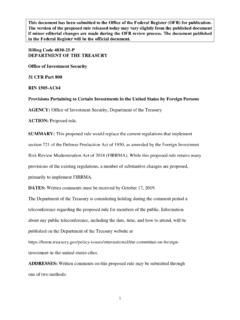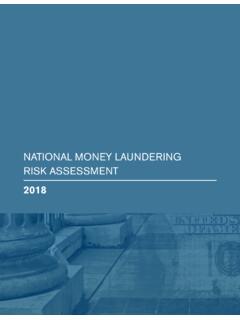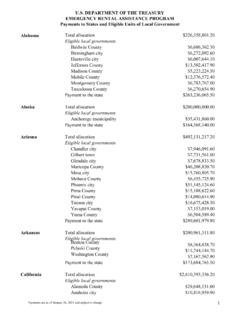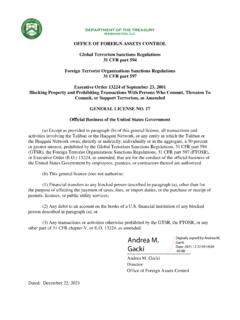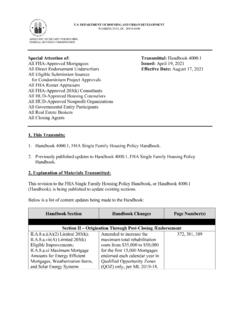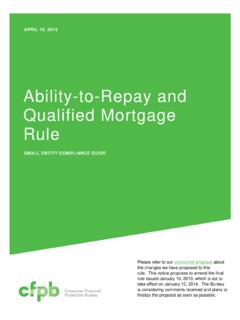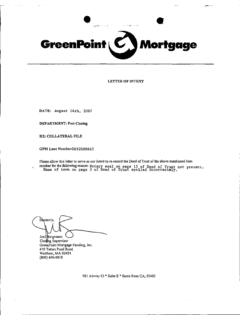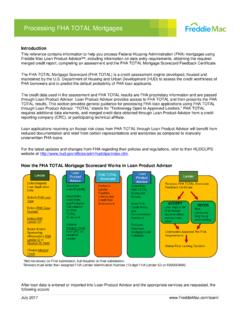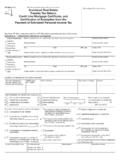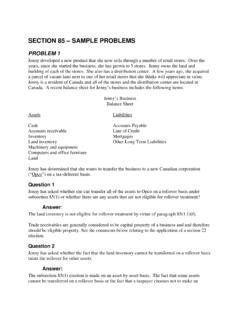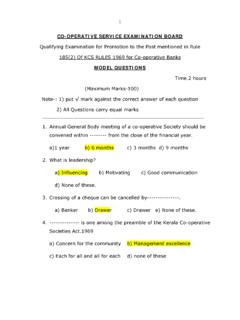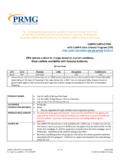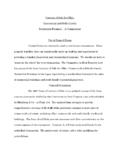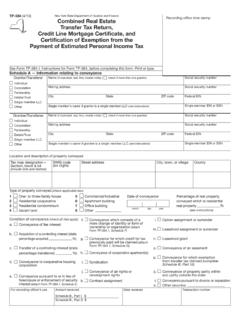Transcription of Coronavirus State and Local Fiscal Recovery Funds Interim ...
1 AS OF JANUARY 2022 1 Coronavirus State and Local Fiscal Recovery Funds Interim Final Rule: Frequently Asked Questions AS OF JANUARY 2022 This document contains answers to frequently asked questions regarding the Interim Final Rule of the Coronavirus State and Local Fiscal Recovery Funds (CSFRF / CLFRF, or Fiscal Recovery Funds ). Treasury will be updating this document periodically in response to questions received from stakeholders. Recipients and stakeholders should consult the Interim Final Rule for additional information. For overall information about the program, including information on requesting funding, please see For general questions about CSFRF / CLFRF, please email Questions added 5/27/21: , , , , , , , , , (noted with [5/27] ) Questions added 6/8/21: , , , , , , , , , (noted with [6/8] ) Questions added 6/17/21: , , , (noted with [6/17] ) Questions added 6/23/21: , , , , , (appendix), , , (noted with [6/23] ) Question added 6/24/21: (noted with [6/24] ) Questions added 7/14/21: , , , , , , , , , , , , updated (noted with [7/14] ) Question added 11/15/21.
2 Questions updated 11/15/21: Answers to frequently asked questions on distribution of Funds to non-entitlement units of Local government (NEUs) can be found in this FAQ supplement, which is regularly updated. Update (January 2022): The FAQs in this document pertain to the Interim Final Rule (IFR), which is in effect until April 1, 2022. In addition to this document, recipients are encouraged to consult the Statement Regarding Compliance with the Coronavirus State and Local Fiscal Recovery Funds Interim Final Rule and Final Rule, which provides guidance on use of Funds until the Final Rule takes effect. Treasury anticipates issuing FAQs for the Final Rule at a later date. Recipients may find helpful the Overview of the Final Rule, which provides a summary of major provision of the Final Rule for informational purposes.
3 AS OF JANUARY 2022 2 1. Eligibility and Allocations Which governments are eligible for Funds ? The following governments are eligible: states and the District of Columbia Territories Tribal governments Counties Metropolitan cities Non-entitlement units, or smaller Local governments Which governments receive Funds directly from Treasury? Treasury will distribute Funds directly to each eligible State , territory, metropolitan city, county, or Tribal government. Smaller Local governments that are classified as non-entitlement units will receive Funds through their applicable State government. Are special-purpose units of government eligible to receive Funds ? Special-purpose units of Local government will not receive funding allocations; however, a State , territory, Local , or Tribal government may transfer Funds to a special-purpose unit of government.
4 Special-purpose districts perform specific functions in the community, such as fire, water, sewer or mosquito abatement districts. How are Funds being allocated to Tribal governments, and how will Tribal governments find out their allocation amounts?1 $20 billion of Fiscal Recovery Funds was reserved for Tribal governments. The American Rescue Plan Act specifies that $1 billion will be allocated evenly to all eligible Tribal governments. The remaining $19 billion will be distributed using an allocation methodology based on enrollment and employment. There will be two payments to Tribal governments. Each Tribal government s first payment will include (i) an amount in respect of the $1 billion allocation that is to be divided equally among eligible Tribal governments and (ii) each Tribal government s pro rata share of the Enrollment Allocation.
5 Tribal governments will be notified of their allocation amount and delivery of payment 4-5 days after completing request for Funds in the Treasury Submission Portal. The deadline to make the initial request for Funds was June 21, 2021. The second payment will include a Tribal government s pro rata share of the Employment Allocation. There is a $1,000,000 minimum employment allocation for Tribal governments. In late-June, Tribal governments will receive an email notification 1 The answer to this question was updated on July 19, 2021. AS OF JANUARY 2022 3 to re-enter the Treasury Submission Portal to confirm or amend their 2019 employment numbers that were submitted to the Department of the Treasury for the CARES Act s Coronavirus Relief Fund. To receive an Employment Allocation, including the minimum employment allocation, Tribal governments must confirm employment numbers by July 23, 2021.
6 Treasury will calculate employment allocations for those Tribal governments that confirmed or submitted amended employment numbers by the deadline. In August, Treasury will communicate to Tribal governments the amount of their portion of the Employment Allocation and the anticipated date for the second payment. My county is a unit of general Local government with population under 50,000. Will my county receive Funds directly from Treasury? [5/27] Yes. All counties that are units of general Local government will receive Funds directly from Treasury and should apply via the online portal. The list of county allocations is available here. My Local government expected to be classified as a non-entitlement unit. Instead, it was classified as a metropolitan city. Why? [5/27] The American Rescue Plan Act defines, for purposes of the Coronavirus Local Fiscal Recovery Fund (CLFRF), metropolitan cities to include those that are currently metropolitan cities under the Community Development Block Grant (CDBG) program but also those cities that relinquish or defer their status as a metropolitan city for purposes of the CDBG program.
7 This would include, by way of example, cities that are principal cities of their metropolitan statistical area, even if their population is less than 50,000. In other words, a city that is eligible to be a metropolitan city under the CDBG program is eligible as a metropolitan city under the CLFRF, regardless of how that city has elected to participate in the CDBG program. Unofficial allocation estimates produced by other organizations may have classified certain Local governments as non-entitlement units of Local government. However, based on the statutory definitions, some of these Local governments should have been classified as metropolitan cities. In order to receive and use Fiscal Recovery Funds , must a recipient government maintain a declaration of emergency relating to COVID-19? [6/23] No. Neither the statute establishing the CSFRF/CLFRF nor the Interim Final Rule requires recipients to maintain a Local declaration of emergency relating to COVID-19.
8 Can non-profit or private organizations receive Funds ? If so, how? [7/14] AS OF JANUARY 2022 4 Yes. Under section 602(c)(3) of the Social Security Act, a State , territory, or Tribal government may transfer Funds to a private nonprofit organization .. , a Tribal organization .. , a public benefit corporation involved in the transportation of passengers or cargo, or a special-purpose unit of State or Local government. Similarly, section 603(c)(3) authorizes a Local government to transfer Funds to the same entities (other than Tribal organizations). The Interim Final Rule clarifies that the lists of transferees in sections 602(c)(3) and 603(c)(3) are not exclusive, and recipients may transfer Funds to constituent units of government or private entities beyond those specified in the statute. A transferee receiving a transfer from a recipient under sections 602(c)(3) and 603(c)(3) will be considered to be a subrecipient and will be expected to comply with all subrecipient reporting requirements.
9 The ARPA does not authorize Treasury to provide CSFRF/CLFRF Funds directly to non-profit or private organizations. Thus, non-profit or private organizations should seek Funds from CSFRF/CLFRF recipient(s) in their jurisdiction ( , a State , Local , territorial, or Tribal government). 2. Eligible Uses Responding to the Public Health Emergency / Negative Economic Impacts What types of COVID-19 response, mitigation, and prevention activities are eligible? A broad range of services are needed to contain COVID-19 and are eligible uses, including vaccination programs; medical care; testing; contact tracing; support for isolation or quarantine; supports for vulnerable populations to access medical or public health services; public health surveillance ( , monitoring case trends, genomic sequencing for variants); enforcement of public health orders; public communication efforts; enhancement to health care capacity, including through alternative care facilities; purchases of personal protective equipment; support for prevention, mitigation, or other services in congregate living facilities ( , nursing homes, incarceration settings, homeless shelters, group living facilities) and other key settings like schools.
10 Ventilation improvements in congregate settings, health care settings, or other key locations; enhancement of public health data systems; and other public health responses. Capital investments in public facilities to meet pandemic operational needs are also eligible, such as physical plant improvements to public hospitals and health clinics or adaptations to public buildings to implement COVID-19 mitigation tactics. If a use of Funds was allowable under the Coronavirus Relief Fund (CRF) to respond to the public health emergency, may recipients presume it is also allowable under CSFRF/CLFRF? Generally, funding uses eligible under CRF as a response to the direct public health impacts of COVID-19 will continue to be eligible under CSFRF/CLFRF, with the following two exceptions: (1) the standard for eligibility of public health and safety AS OF JANUARY 2022 5 payrolls has been updated; and (2) expenses related to the issuance of tax-anticipation notes are not an eligible funding use.
